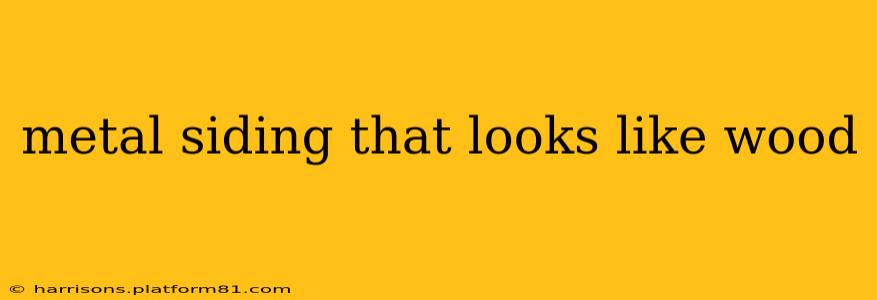Metal siding has become increasingly popular for its durability, low maintenance, and longevity. But what if you crave the classic aesthetic of wood siding without the drawbacks? Fortunately, advancements in metal siding technology have created products that convincingly mimic the look of wood, offering the best of both worlds. This comprehensive guide delves into the world of metal siding that looks like wood, exploring its benefits, considerations, and everything you need to know before making a decision.
What are the Benefits of Metal Siding That Looks Like Wood?
Metal siding designed to resemble wood offers a compelling combination of aesthetics and practicality. Let's explore the key advantages:
-
Durability: Unlike wood, metal siding is highly resistant to rot, insect infestation, and warping. It can withstand harsh weather conditions, including extreme temperatures, heavy rain, and strong winds, for decades without significant deterioration. This translates to lower long-term maintenance costs.
-
Low Maintenance: Forget about regular painting, staining, or caulking. Metal siding requires minimal upkeep, typically just an occasional cleaning to remove dirt and debris. This significantly reduces the time and effort invested in home maintenance.
-
Fire Resistance: Metal siding is inherently fire-resistant, offering an added layer of protection for your home. This is a significant advantage over wood siding, which is highly combustible.
-
Cost-Effective: While the initial investment might be higher than some wood siding options, the long-term cost savings associated with reduced maintenance and increased lifespan make metal siding a cost-effective choice in the long run.
-
Aesthetic Appeal: Modern manufacturing techniques allow for incredibly realistic wood grain textures and color variations, producing siding that is virtually indistinguishable from real wood from a distance. You get the beauty of wood without the drawbacks.
What are the Different Types of Metal Siding That Looks Like Wood?
Several types of metal siding effectively mimic the appearance of wood:
-
Aluminum Siding: Lightweight and relatively inexpensive, aluminum siding is a popular choice. It's available in a wide range of colors and finishes designed to replicate various wood types.
-
Steel Siding: Known for its superior strength and durability, steel siding provides exceptional protection against impact damage and harsh weather. It can be coated with a variety of finishes to achieve a realistic wood look.
-
Zinc Siding: Zinc siding offers a unique, naturally weathering patina that develops over time, adding character and visual interest. While it doesn't typically mimic the exact appearance of wood, its rustic texture can be appealing to those seeking a more natural look.
How Much Does Metal Siding That Looks Like Wood Cost?
The cost of metal siding that looks like wood varies depending on several factors:
-
Type of Metal: Steel siding generally costs more than aluminum siding.
-
Finish and Color: More complex finishes and custom colors may increase the overall cost.
-
Installation: Labor costs can significantly impact the total price. The complexity of the installation, including the home's size and design, will influence this factor.
-
Regional Variations: Pricing can fluctuate based on location and market conditions.
It's best to obtain multiple quotes from reputable contractors in your area to get a precise estimate for your project.
How Long Does Metal Siding That Looks Like Wood Last?
With proper installation and maintenance, metal siding that looks like wood can last for 50 years or more. This significantly surpasses the lifespan of most wood siding options. The exact lifespan will depend on the quality of the materials, the installation, and the climate in your region.
Is Metal Siding That Looks Like Wood a Good Investment?
Yes, for many homeowners, metal siding that looks like wood is a smart investment. The combination of long-term durability, low maintenance, and the aesthetic appeal of wood makes it a worthwhile consideration. The increased property value and reduced long-term costs often outweigh the initial investment.
How is Metal Siding That Looks Like Wood Installed?
The installation process involves attaching the panels to your home's exterior using specialized fasteners. Professionals typically use a system that allows for expansion and contraction due to temperature fluctuations. It's crucial to hire a qualified and experienced installer to ensure proper installation and a long-lasting result. Improper installation can compromise the siding's performance and longevity.
What are the Potential Drawbacks of Metal Siding That Looks Like Wood?
While metal siding offers many advantages, it's important to be aware of some potential drawbacks:
-
Denting: Although durable, metal siding can be dented by impacts.
-
Noise: During heavy rain or hail, metal siding can be somewhat noisy.
-
Expansion and Contraction: While designed to account for temperature changes, some expansion and contraction can occur, potentially leading to minor gaps over time.
In conclusion, metal siding that looks like wood provides an excellent alternative to traditional wood siding, offering a compelling blend of aesthetics, durability, and cost-effectiveness. By carefully weighing the advantages and disadvantages and selecting a reputable installer, you can enjoy the beauty of wood-like siding with the added benefits of a long-lasting, low-maintenance exterior.
